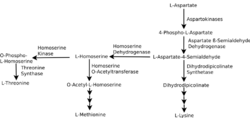Chemistry:L-Aspartic-4-semialdehyde

| |
| Names | |
|---|---|
| IUPAC name
L-Aspart-4-al
| |
| Systematic IUPAC name
(2S)-2-Amino-4-oxobutanoic acid | |
| Other names
L-Aspartate-β-semialdehyde
| |
| Identifiers | |
3D model (JSmol)
|
|
| ChEBI | |
| ChemSpider | |
| KEGG | |
PubChem CID
|
|
| UNII | |
| |
| |
| Properties | |
| C4H7NO3 | |
| Molar mass | 117.104 g·mol−1 |
| Appearance | Solid |
Except where otherwise noted, data are given for materials in their standard state (at 25 °C [77 °F], 100 kPa). | |
| Infobox references | |
L-Aspartic-4-semialdehyde (also L-aspartate-4-semialdehyde) is an α-amino acid derivative of aspartate. It is an important intermediate in the aspartate pathway, which is a metabolic pathway present in bacteria and plants. The aspartate pathway leads to the biosynthesis of a variety of amino acids from aspartate, including lysine, methionine, and threonine.[1]
Aspartate pathway
The aspartate pathway is an amino acid metabolic pathway present in bacteria and plants that deal with converting aspartate to other amino acids through a series of reactions and intermediates. L-Aspartate-4-semialdehyde serves as one of the first intermediates in the pathway and as an important step of differentiation in the pathway.[2]
L-Aspartate-4-semialdehyde is synthesized by the enzyme aspartate semialdehyde dehydrogenase, which catalyzes the following reversible chemical reaction:
- L-4-Aspartyl phosphate + NADPH + H+ [math]\displaystyle{ \rightleftharpoons }[/math] L-aspartate-4-semialdehyde + NADP+ + phosphate
Once L-aspartate-4-semialdehyde is synthesized, the molecule can then progress down a number of pathways. One possible pathway requires L-aspartate-4-semialdehyde to undergo a reaction catalyzed by the enzyme dihydropicolinate synthase in order to form the molecule dihydrodipicolinate. This reversible chemical reaction is shown below:[3]
- L-Aspartate-4-semialdehyde + pyruvate [math]\displaystyle{ \rightleftharpoons }[/math] dihydrodipicolinate + H2O
Once dihydrodipicolinate is synthesized, it can continue down the metabolic pathway leading to the synthesis of lysine.[4] Other than the lysine biosynthetic pathway, L-aspartate-4-semialdehyde can also undergo a reversible reaction catalyzed by the enzyme homoserine dehydrogenase. This reaction, which turns L-aspartate-4-semialdehyde into homoserine is shown below:[5]
- L-Aspartate-4-semialdehyde + NAD(P)H + H+ [math]\displaystyle{ \rightleftharpoons }[/math] homoserine + NAD(P)+
Homoserine represents another branch in the aspartate pathway, as it can progress down one of two pathways to eventually become one of two amino acids: threonine or methionine. This aspartate pathway is present in plants and bacteria, allowing them to synthesize lysine, methionine, and threonine. This pathway is not present in humans or other animals, however. The lack of this pathway means that humans need to take in these amino acids through their diet, which is why they are called essential amino acids.[6][7]
References
- ↑ Viola, Ronald E. (2001). "The Central Enzymes of the Aspartate Family of Amino Acid Biosynthesis". Accounts of Chemical Research 34 (5): 339–349. doi:10.1021/ar000057q. PMID 11352712.
- ↑ Thangavelu, B.; Bhansali, P.; Viola, R.E. (2015-10-15). "Elaboration of a fragment library hit produces potent and selective aspartate semialdehyde dehydrogenase inhibitors". Bioorganic & Medicinal Chemistry 23 (20): 6622–6631. doi:10.1016/j.bmc.2015.09.017. PMID 26404410.
- ↑ Mazelis, M.; Whatley, F.R.; Whatley, J. (December 1977). "The enzymology of lysine biosynthesis in higher plants. The occurrence, characterization and some regulatory properties of dihydrodipicolinate synthase". FEBS Letters 84 (2): 236–240. doi:10.1016/0014-5793(77)80696-0. PMID 598503.
- ↑ Viola, R.E.; Faehnle, C.R.; Blanco, J.; Moore, R.A.; Liu, X.; Arachea, B.T.; Pavlovsky, A.G. (2010-12-22). "The Catalytic Machinery of a Key Enzyme in Amino Acid Biosynthesis". Journal of Amino Acids 2011: 352–538. doi:10.4061/2011/352538. PMID 22332000.
- ↑ Thomas, D.; Barbey, R.; Surdin-Kerjan, Y. (June 1993). "Evolutionary relationships between yeast and bacterial homoserine dehydrogenases". FEBS Letters 323 (3): 289–293. doi:10.1016/0014-5793(93)81359-8. PMID 8500624.
- ↑ Viola, R.E.; Faehnle, C.R.; Blanco, J.; Moore, R.A.; Liu, X.; Arachea, B.T.; Pavlovsky, A.G. (2010-12-22). "The Catalytic Machinery of a Key Enzyme in Amino Acid Biosynthesis". Journal of Amino Acids 2011: 352–538. doi:10.4061/2011/352538. PMID 22332000.
- ↑ Berg, Jeremy M.; Tymoczko, John L.; Gatto, Gergory J. Jr.; Stryer, Lubert (2015). Biochemistry. New York, NY: W.H. Freeman and Company. p. 719. ISBN 978-1-4641-2610-9.
 |


